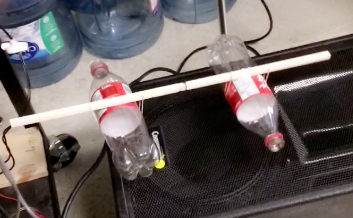Construction
Download video of my demonstration
Materials
- A pair of identical plastic pop bottles — I used two 710 mL Coca-Cola bottles
- Woofer, or any loudspeaker capable of playing low-frequency sounds
- Frequency generator
- Amplifier
- Wooden stick, 0.5 m long
- Thread
- Two rubber bands
- Pair of earplugs
Assembly
- Connect the frequency generator to the amplifier. Then connect the amplifier to the woofer.
- Determine the natural frequency of the bottles. I did this by placing a strip of paper on the edge of the bottle's opening and playing different frequencies. The strip of paper began to vibrate rigorously as I narrowed in on the natural frequency. For my bottles, I found this to be at 189 Hz.
- Using the rubber bands, attach the middle of each bottle to either end of the stick. The bottles should be oriented such that their openings are facing in opposite directions as shown in Figure 1.
- Position the woofer so that it is facing upwards.
- Tie one end of the string around the center of the stick and suspend the system a few centimeters above the woofer. Ensure that the bottles are level (so that the stick is not tilting to one side or the other). See Figure 1 again.
- Wear the earplugs and use the frequency generator to play the natural frequency of the bottles. Note that this sound needs to be very loud (at least 100 dB) in order to generate movement.

Points to Consider
- Note that it is possible to use any pair of bottles, as long as they are identical. Other helmholtz resonators can also be used (such as ornaments).
- It is a good idea to use a sturdy string/thread that is not highly susceptible to torsion. When the bottles spin, the string will begin to twist as well, which may interfere with the overall rotation of the system.
- The natural frequency can also be determined by blowing across the bottle and recording the sound on a computer. An audio software can be downloaded and used to determine the frequency of this sound recording.